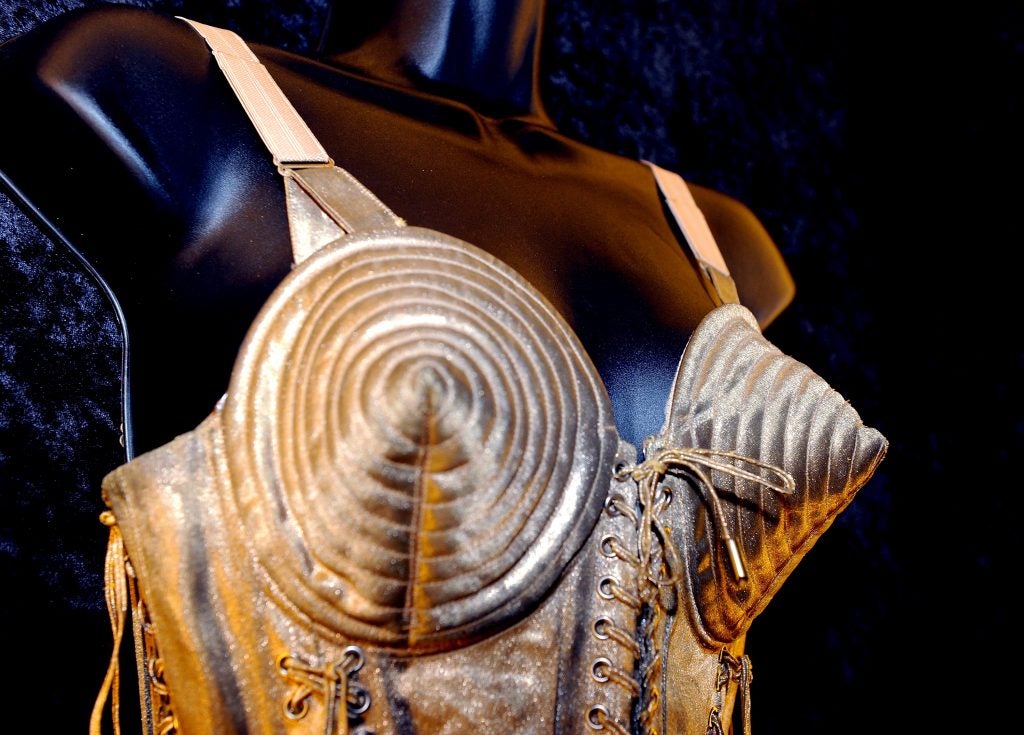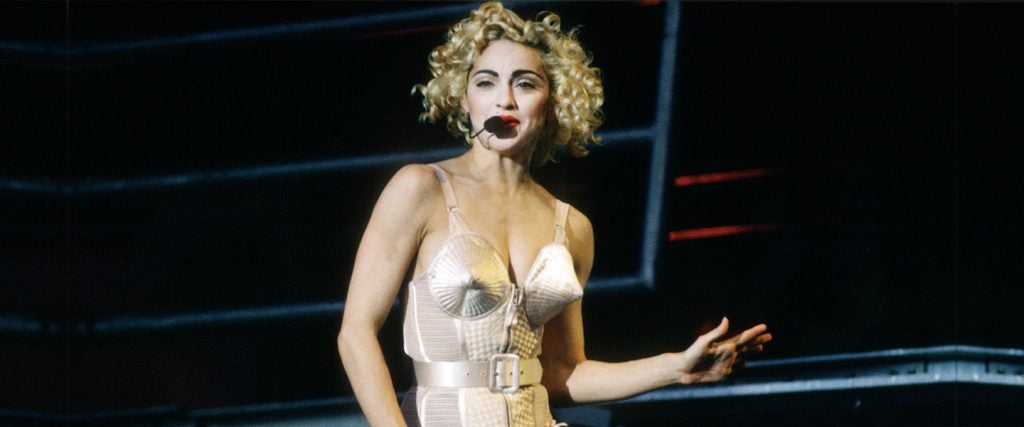Big naturals are more than just a body part. They’re an energy, a culture, a lens through which we consume and create the world around us. And while big-breastedness may be both spiritual and bodily, there is a material world and timeline of events that document how this culture came to be. As MEL’s resident boob culture writer and a woman of breast-experience, I’ll be analyzing these objects and happenings, telling the stories of their origins and their impact on society. This is Big Moments in Big Naturals.
Before Madonna ever wore her infamous cone bra during her 1990 Blond Ambition tour, the style belonged to a teddy bear. “I wanted to have a doll, but my parents said, ‘For a boy? No, no — a teddy bear,’” designer Jean Paul Gaultier told British news show This Morning in 2019. Hoping to give the bear a more feminine figure, he made it a tiny cone bra with paper and pins and named it Nana, so it was “more like a girl.”
The paper bra was a sort of desperate, DIY attempt at recreating the bullet bras of the 1940s and 1950s, a garment that gave breasts a structured conical shape with a rigid point at the nipple. Almost every bra from this era took on this kind of build, relying on the early underwire technology from 1938 and the sewing limitations of the time — for the most part, bullet bras of the 1940s were the result of how seams and fabric lay in order to create a breast shape. Considered to be ultra-feminine, this style became even more fashionable and exaggerated by the 1950s, with stitching designed to make breasts as pointy as possible.
Gaultier’s cone bra, by contrast, was more geometrically simple, relying strictly on the cone in its purest form (it was, after all, a child’s attempt). But in 1989, after receiving a call from the biggest pop star in the world, the then 37-year-old designer decided to revive Nana’s breasts once more.
And with that, Madonna’s cone bra was born. Still carrying much of the same constructed femininity as it did when Nana first wore it, Madonna’s was made of a creamy pink satin that extended down into a belted bodysuit accented with garters. At the time, it was nothing short of revolutionary. “In 1990, we were heading into a decade of Baywatch, Pam Anderson, big, round fake boobs and women’s bodies being overtly sexualized,” Jené Luciani Sena, bra and style expert and author of The Bra Book, tells me. “Madonna, with her athletic, almost masculine figure — with no soft round edges — did the opposite.”

On the first night of her tour in Chiba, Japan, Sena says Madonna “came out in a pinstripe suit and tore it off to reveal the corset beneath.” Except, the piercing breast shapes on the corset weren’t soft, round and feminine — they were “pointy, and potentially deadly.”
This blending of masculine and feminine to the point of parody was precisely the look Madonna was striving for. She didn’t want to accentuate her breasts — she wanted to accentuate the idea of breasts. Or perhaps, the potential of breasts, namely their ability to exert power. With the suit, she portrayed a stereotypical form of masculine soft power, like a CEO or business executive. She even wore a monocle, like the Monopoly man. But by stripping the suit to show the cone bra, she presented a brazen, feminine alternative. This womanly power isn’t soft or implied, but hard and explicit. Like a weapon, the cone bra presents the threat of violence.
“Madonna birthed a major fashion moment and, essentially, a liberation for women’s sartorial expression,” explains Cody Rooney, editor-in-chief of Liminul, an arts and culture publication in Montreal. “It both normalized and made visible a women’s undergarment, which, at the time, was much more controversial than today.” On a much more basic level, Madonna’s outfit popularized the concept of the undergarment as outer-garment. Per Rooney, this trend had previously started in the countercultural street fashion world, but it’s continued in celebrity, runway and everyday fashion ever since Madonna. Today, it’s not uncommon to see people wear corsets and bras as tops, for example.
That said, many of the more famous reincarnations of Madonna’s bra play further into the weapon symbolism. “The cone bra has been reimagined by younger stars, including Lady Gaga, who substituted the pink cones for conical flamethrowers, and even more famously, machine guns,” says Rooney. “Katy Perry answered the cone bra with her own sugary-sweet confectionary interpretation, donning cans of whipped cream over her breasts.”
Both of these inceptions could have drawn inspiration from a more obvious instance of breasts-as-weapons, namely the fembots from Austin Powers and their precursors from The Tenth Victim. But that’s part of what made Madonna’s look so iconic — she was saying these things without actually saying them. This is ultimately much of the cultural theme of breasts writ large, and a testament to their ability to be imbued with innuendo and overtone by doing nothing more than being present. They needn’t even be attached to a human to be important — Nana the Bear and all that she inspired proves that.

